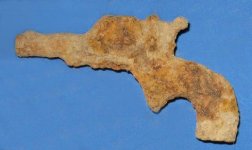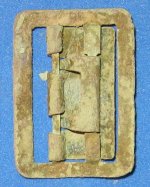Breezie
Gold Member
- Oct 3, 2009
- 6,269
- 2,119
- 🥇 Banner finds
- 1
- Detector(s) used
- White's DFX & Spectrum~Garrett's Pro-Pointer~VibraProbe
- Primary Interest:
- Metal Detecting
UPDATE: The before and after electrolysis pics are posted on Today's Finds. Here is the link:
http://forum.treasurenet.com/index.php?topic=423067.msg3016733#msg3016733
Hey Gang, This afternoon I MD an hour or so and had a productive dig. I think I found a SAMBO cap gun. The cast iron SAMBO was made by Ives, dated June 21, 1887. The shape is right, the length is right, plus I went through all 199 pages of Cast Iron Toy Pistols by Charles W. Best, and this was the best match. I think it is worth electrolysis, although I've never 'fried' anything before, but understand it is a simple process. Can the electrolysis take it down to nothing if the rust is throughout?
I also found a small brass buckle with 2 prongs; it looks like a suspender buckle. The cotter pin is a strange one in that I've never seen one with equal length legs. Every one I've ever seen had one leg longer than the other so it could be opened easily, but I'm not the 'tool time' person.
Any thoughts would be appreciated.
PS: When I saw this in the dirt, partially covered, I thought it was a boot pistol, and was short of calling 911!
 Breezie
Breezie
http://forum.treasurenet.com/index.php?topic=423067.msg3016733#msg3016733
Hey Gang, This afternoon I MD an hour or so and had a productive dig. I think I found a SAMBO cap gun. The cast iron SAMBO was made by Ives, dated June 21, 1887. The shape is right, the length is right, plus I went through all 199 pages of Cast Iron Toy Pistols by Charles W. Best, and this was the best match. I think it is worth electrolysis, although I've never 'fried' anything before, but understand it is a simple process. Can the electrolysis take it down to nothing if the rust is throughout?
I also found a small brass buckle with 2 prongs; it looks like a suspender buckle. The cotter pin is a strange one in that I've never seen one with equal length legs. Every one I've ever seen had one leg longer than the other so it could be opened easily, but I'm not the 'tool time' person.
Any thoughts would be appreciated.
PS: When I saw this in the dirt, partially covered, I thought it was a boot pistol, and was short of calling 911!
 Breezie
Breezie







 You might want to do a copy/paste and also post it under the cleaning relics forum. I know it will be beneficial to me as well as others.
You might want to do a copy/paste and also post it under the cleaning relics forum. I know it will be beneficial to me as well as others. 
 Seriously though I hope you and yours are all OK and everything gets back to normal for you soon, take care.
Seriously though I hope you and yours are all OK and everything gets back to normal for you soon, take care.


